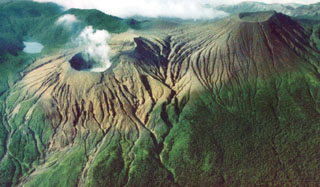Report on Rincon de la Vieja (Costa Rica) — April 2019
Bulletin of the Global Volcanism Network, vol. 44, no. 4 (April 2019)
Managing Editor: Edward Venzke.
Research and preparation by Paul Berger.
Rincon de la Vieja (Costa Rica) Occasional weak phreatic explosions continue through February 2019
Please cite this report as:
Global Volcanism Program, 2019. Report on Rincon de la Vieja (Costa Rica) (Venzke, E., ed.). Bulletin of the Global Volcanism Network, 44:4. Smithsonian Institution. https://doi.org/10.5479/si.GVP.BGVN201904-345020
Rincon de la Vieja
Costa Rica
10.83°N, 85.324°W; summit elev. 1916 m
All times are local (unless otherwise noted)
Intermittent small phreatic explosions from the acid lake of Rincón de la Vieja's active crater has most recently occurred since 2011 (BGVN 42:08, 43:03, and 43:09). This activity continued through at least February 2019. The volcano is monitored by the Observatorio Vulcanologico Sismologica de Costa Rica-Universidad Nacional (OVSICORI-UNA), and the information below comes from its weekly bulletins between 18 August 2018 and 28 February 2019. Weather conditions often prevented webcam views and estimates of plume heights. The volcano was in Activity Level 3 throughout the reporting period (volcano erupting, steady state).
According to OVSICORI-UNA, two distinct, 2-minute-long explosions occurred on 31 August 2018 beginning at 0434 and 1305. Several hours after the eruption tremor became continuous but low-frequency long-period (LP) earthquakes ceased. OVSICORI-UNA reported a gas emission late on 7 September. An unconfirmed small phreatic explosion occurred on 11 September at 0634, and another on 17 September at 1014. The seismic record showed continuous background tremor and very sporadic LP earthquakes.
Intermittent background tremor was recorded during the first half of October, along with a few emissions and phreatic explosions. Deformation measurements during October showed a contraction between the N and S of the volcano, with subsidence. On 17 October there was another phreatic explosion, and thereafter tremor disappeared and seismicity decreased. On 23 and 27 October seismic stations signaled additional possible phreatic explosions.
OVSICORI-UNA reported that a series of explosions began at 1945 on 4 November and consisted of at least three 2-minute-long episodes. The next day at 1511 a plume of water vapor and diffuse gas, recorded by a webcam and visible to residents to the N, rose about 100 m above the crater rim and drifted W. On 9 November a 2-minute-long explosion began at 1703. Another explosion on 27 November at 0237 produced a plume of water vapor and gas that rose 600 m above the crater rim and drifted SW. A short 1-minute explosion began at 1054 on 3 December.
Based on OVSICORI-UNA weekly bulletins, activity remained stable in January 2019 with small-amplitude phreatic explosions on 11, 12, and 14 January. More energetic phreatomagmatic explosions on 17 and 20 January produced lahars. Several small-amplitude explosions were detected at the end of the month. During January, a few LPs, no VTs, and intermittent tremor were recorded.
OVSICORI-UNA reported that two small-scale explosions occurred on 1 February, along with possible events at 1906 and 1950 on 5 February and at 0120 on 6 February. An event at 0000 on 6 February was also recorded; the report noted that poor weather conditions prevented visual observations of the crater. On 16 and 17 February strong degassing was observed. No LPs were recorded, but two significant VTs were detected on 17 and 22 February near or under the crater.
Geological Summary. Rincón de la Vieja, the largest volcano in NW Costa Rica, is a remote volcanic complex in the Guanacaste Range. The volcano consists of an elongated, arcuate NW-SE-trending ridge constructed within the 15-km-wide early Pleistocene Guachipelín caldera, whose rim is exposed on the south side. Sometimes known as the "Colossus of Guanacaste," it has an estimated volume of 130 km3 and contains at least nine major eruptive centers. Activity has migrated to the SE, where the youngest-looking craters are located. The twin cone of Santa María volcano, the highest peak of the complex, is located at the eastern end of a smaller, 5-km-wide caldera and has a 500-m-wide crater. A Plinian eruption producing the 0.25 km3 Río Blanca tephra about 3,500 years ago was the last major magmatic eruption. All subsequent eruptions, including numerous historical eruptions possibly dating back to the 16th century, have been from the prominent active crater containing a 500-m-wide acid lake located ENE of Von Seebach crater.
Information Contacts: Observatorio Vulcanologico Sismologica de Costa Rica-Universidad Nacional (OVSICORI-UNA), Apartado 86-3000, Heredia, Costa Rica (URL: http://www.ovsicori.una.ac.cr/).

